Featured image: Creative Commons License by Nicholastbroussard
James Hetfield, the rhythm guitarist and co-founder of Metallica, has crafted a distinct sound over the years, a sonic signature shaped by his choice of guitars, amplifiers, and effects.
Ready to embark on a journey through the gear that has defined Hetfield’s iconic sound? Buckle up, because we’re about to dive headfirst into the history and specifics of James Hetfield guitars and gear!
A summary of James Hetfield’s guitars and gear
| Brand | Model | Used Since |
|---|---|---|
| Gibson | Electra 2236 Flying V | 1980 |
| Gibson | Explorer (“So What” & “More Beer”) | 1984 |
| Jackson | King V Custom | 1985 |
| ESP | James Hetfield Iron Cross | Late-2010s |
| ESP | James Hetfield Snakebyte | Mid-2010s |
| ESP | James Hetfield Snakebyte Custom Baritone | Mid-2010s |
| Ken Lawrence | Explorer (“Carl”) | Late-2010s |
| Ken Lawrence | 1996 Custom Explorer | 1996 |
| Marshall | JCM800 | 1984 |
| Marshall | JMP 2203 | 1982 |
| Mesa Boogie | Mark IIC+ | 1984 |
| Mesa Boogie | Mark V | Early-2010s |
| Mesa Boogie | Triple Rectifier | Early-2010s |
| Wizard | Modern Classic | Late-1990s |
| Diezel | VH4 | 2002 |
| ProCo | Rat | 1983 |
| Line 6 | DM4 Distortion Modeler | 2002 |
| Line 6 | DL4 Delay Modeler | 2002 |
| Ibanez | TS9 Tube Screamer | 1983 |
| Klon | Centaur | 2012 |
| MXR | M107 Phase 100 | Early-2010s |
| Ernie Ball | RPS Slinkys | Unknown |
| Ernie Ball | Hardwired | 2022 |
| Dunlop | Tortex .88mm | Unknown |
| Dunlop | James Hetfield Flow White Fang 1.0mm | 2019 |
James Hetfield’s iconic guitars
James Hetfield’s array of iconic guitars is as diverse as Metallica’s discography. Each instrument has its own unique role in shaping Hetfield’s dynamic sound and contributing to the evolution of metal music.
Let’s explore the stories behind these noteworthy guitars and the sonic landscapes they’ve helped create.
Gibson Electra 2236 Flying V
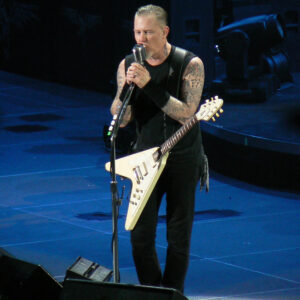
Creative Commons License by Nick Ares
Used since: 1980
Just as every great story has a beginning, every legendary guitarist has their first guitar. For James Hetfield, it was the Electra 2236 Flying V.
This Gibson Flying V was not just an instrument, but a stepping stone on Hetfield’s path to becoming a rhythm guitarist icon.
The Electra 2236 was the vehicle for Hetfield’s riffs on Metallica’s debut album, Kill ‘Em All. Decades later, in 2008, this guitar was restored, with the original Seymour Duncan Invader pickups replaced with EMG ones, giving this classic instrument a modern touch.
The Electra 2236 Flying V holds a special place in Hetfield’s collection, a testament to his musical roots and the thrash metal revolution he was about to lead.
Despite its humble beginnings, this guitar has earned its place in the annals of rock history, not only for its role in Hetfield’s early career but also for the influence it had on the evolution of his playing style.
PRO TIP: Looking to replicate this tone on a budget? The Epiphone Flying V Prophecy is a great alternative!
Gibson Explorers: “So What” and “More Beer”
Used since: 1984
Hetfield’s journey with Gibson didn’t end with the Electra 2236 Flying V. The Gibson Explorers, “So What” and “More Beer,” became his main axes during the 1980s, solidifying his bond with the brand.
These guitars were not just instruments; they were extensions of Hetfield’s musical identity, emblazoned with his uncompromising attitude and fearless approach to music.
Boasting high-output EMG pickups and adorned with various stickers, these guitars bore the marks of Hetfield’s musical evolution. They went through numerous upgrades, reflecting Hetfield’s relentless pursuit of perfecting his sound.
From their solid mahogany bodies to their EMG pickups, every element of the “So What” and “More Beer” Explorers contributed to Hetfield’s signature tone, a testament to his mastery and influence as a rhythm guitarist.
Jackson King V Custom “Kill Bon Jovi”
Used since: 1985
Beyond the realm of Gibson and Jackson guitars, another guitar that played a significant role in Hetfield’s career was the Jackson King V Custom “Kill Bon Jovi”. This guitar, with its distinctive “Kill Bon Jovi” sticker, was the epitome of Hetfield’s rebellious spirit and his stand against the mainstream music of the time.
Under its rebellious exterior, the “Kill Bon Jovi” was a powerhouse of sound thanks to the Seymour Duncan Invaders being replaced with EMG’s 81 and 60 humbuckers. This modification not only enhanced the guitar’s sound but also contributed to the heavy, aggressive tone Hetfield is famous for.
The Jackson King V Custom “Kill Bon Jovi” represents a pivotal moment in Hetfield’s career, highlighting his commitment to pushing the boundaries of metal music.
Signature ESP Guitars
From the early days of Gibson and Jackson, Hetfield’s journey led him to ESP Guitars, a brand that recognised his influence and offered him the opportunity to design his own signature models.
These guitars not only became a significant part of Hetfield’s guitar rig but also served as a testament to his influence on the world of metal music.
ESP James Hetfield Iron Cross
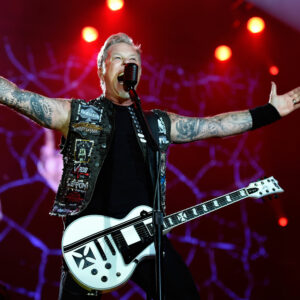
Creative Commons License by Tommy Holl
Used since: Late-2010s
The ESP Iron Cross is a guitar that commands attention, mirroring Hetfield’s own commanding presence on stage.
Inspired by Hetfield’s 1973 Gibson Les Paul Custom, the Iron Cross boasts a distinct fretboard design and a striking Maltese cross inlay, blending classic aesthetics with a modern edge.
This electric guitar is more than just a stylish instrument. The Iron Cross’s unique design, combined with its EMG pickups and an Ibanez Tube Screamer, contributes to Hetfield’s heavy, aggressive sound, making it an essential part of his guitar arsenal.
From its mahogany body and neck to its rosewood fingerboard, every detail of the Iron Cross is a reflection of Hetfield’s commitment to quality and his relentless pursuit of the perfect tone.
ESP James Hetfield Snakebyte
Used since: Mid-2010s
The ESP Snakebyte is another chapter in Hetfield’s story with ESP. It features a variation of the Explorer body shape, mahogany body and neck, ebony fretboard, and EMG signature humbuckers.
This guitar is a testament to Hetfield’s unique style and his influence on the design of modern metal guitars.
The Snakebyte is not just an instrument; it’s an extension of Hetfield’s musical vision. Its distinct design and features reflect his approach to music, combining power and precision to deliver a sound that is unmistakably Hetfield.
Whether it’s being used to deliver crushing riffs on stage or intricate melodies in the studio, the Snakebyte is a guitar that embodies Hetfield’s commitment to his craft.
ESP James Hetfield Snakebyte Custom Baritone
Used since: Mid-2010s
The ESP Snakebyte Custom Baritone is a testament to Hetfield’s musical diversity. Designed for songs like “Sad But True” due to its longer baritone-style scale length, this guitar showcases Hetfield’s ability to adapt his playing style to suit different musical contexts.
The Snakebyte Custom Baritone is not just a guitar; it’s a tool that allows Hetfield to explore new sonic territories. Featuring a mahogany body and neck and ebony fretboard, it’s designed to deliver heavy riffs and melodic solos.
Ken Lawrence Customs
In the realm of custom guitars, Ken Lawrence holds a special place in Hetfield’s heart.
These guitars not only showcase Lawrence’s craftsmanship but also reflect Hetfield’s personal taste and style. Hetfield’s appreciation for Lawrence’s work is evident in the fact that Lawrence’s work is well known.
The guitarist has built several guitars for Hetfield, including the sentimental “Carl” and a 1996 Custom Explorer. Each features EMG-JH pickups, which boast gigantic volume output and superb tonal range.
Ken Lawrence Explorer “Carl”
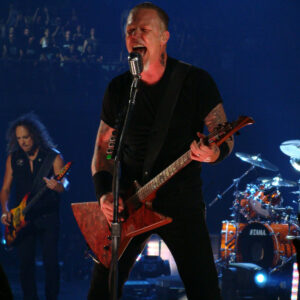
Creative Commons License by Alberto Cabello
Used since: Late-2010s
“Carl” is a Ken Lawrence Explorer with a story as unique as its name. Made from wood from Metallica’s old rehearsal garage, this guitar is a piece of Metallica’s history.
Its unique features, including aesthetic touches by Petar Milivojevi, make it a standout piece in Hetfield’s collection.
However, “Carl” is more than just a guitar; it’s a connection to Hetfield’s musical roots. Every time he plays it, he’s reminded of the journey he’s taken from that old garage to the world’s biggest stages.
“Carl” represents not just Hetfield’s past, but his commitment to preserving his musical heritage while pushing the boundaries of metal music.
1996 Custom Ken Lawrence Explorer
Used since: 1996
The 1996 Custom Ken Lawrence Explorer is another testament to Hetfield’s affinity for unique guitars.
This guitar, which has accompanied Hetfield in many live shows, features unique features and EMG-JH pickups, encapsulating Hetfield’s signature sound in a distinct design.
But the 1996 Custom Explorer is not just about looks and sound. It represents Hetfield’s commitment to quality and his pursuit of the perfect tone.
Whether it’s used to deliver powerful riffs or intricate solos, this guitar embodies the spirit of exploration and innovation that defines Hetfield as a musician.
Amplifiers and effects
Beyond guitars, amplifiers and effects are an integral part of Hetfield’s sound.
From early Marshall models to Mesa Boogie Mark series, Mesa Boogie Triple Rectifier, and Diezel VH4 amps, these tools have shaped Hetfield’s sonic landscape, giving his music its depth and dimension.
In this context, it’s essential to consider the role of guitar gear in achieving his signature sound.
Along with a selection of effects pedals, including the Digitech Whammy, James Hetfield’s guitar amps have been key in creating the signature Hetfield sound we all know and love.
Amplifiers
Hetfield’s amplifiers are as diverse as his guitars, contributing to his evolving sound throughout his career.
From the early days of using iconic Marshall amps like the JMP 2203 and JCM800 to his later exploration of Mesa Boogie and Diezel amps, each has played a significant role in shaping the sound of Metallica and the genre of metal music as a whole.
Here are some of the most-notable amplifiers that James Hetfield has used:
Marshall JCM800
Used since: 1984
Known for its powerful and aggressive tone, the Marshall JCM800 was a staple in Hetfield’s early years. Its classic British crunch provided the foundation for Metallica’s intense sound.
Marshall JMP 2203
Used since: 1982
Another classic Marshall model, the JMP 2203, also contributed to Hetfield’s early tone. It delivered a raw and dynamic sound that added depth and punch to his heavy rhythm guitar playing.
Mesa Boogie Mark IIC+
Used since: 1984
This Mesa Boogie amp became an integral part of Hetfield’s setup in the mid-1980s. The Mark IIC+ offered a rich, tight, and highly versatile tone, allowing him to achieve both searing high gain and smooth cleans.
Mesa Boogie Mark V
Used since: Early 2010s
In later years, Hetfield incorporated the Mesa Boogie Mark V into his rig. This amplifier provided a wide range of tonal options, from vintage-inspired sounds to modern high-gain tones, giving Hetfield increased flexibility on stage and in the studio.
Mesa Boogie Triple Rectifier
Used since: Early 2010s
Known for its massive and aggressive sound, the Mesa Boogie Triple Rectifier became a go-to amplifier for Hetfield during Metallica’s heavier and more aggressive periods. Its high-gain capabilities and tight low-end response perfectly complemented his aggressive rhythm playing.
Wizard Modern Classic
Used since: Late-1990s
While less widely known, the Wizard Modern Classic amp has also made appearances in Hetfield’s rig. It offers a boutique tone with exceptional clarity, tightness, and excellent dynamic response.
Diezel VH4
Used since: 2002
Hetfield’s exploration of different amplifier brands led him to the Diezel VH4. This German-made amp provided a modern and tight tone with exceptional clarity, allowing Hetfield to achieve precise articulation and heavy punch in his guitar sound.
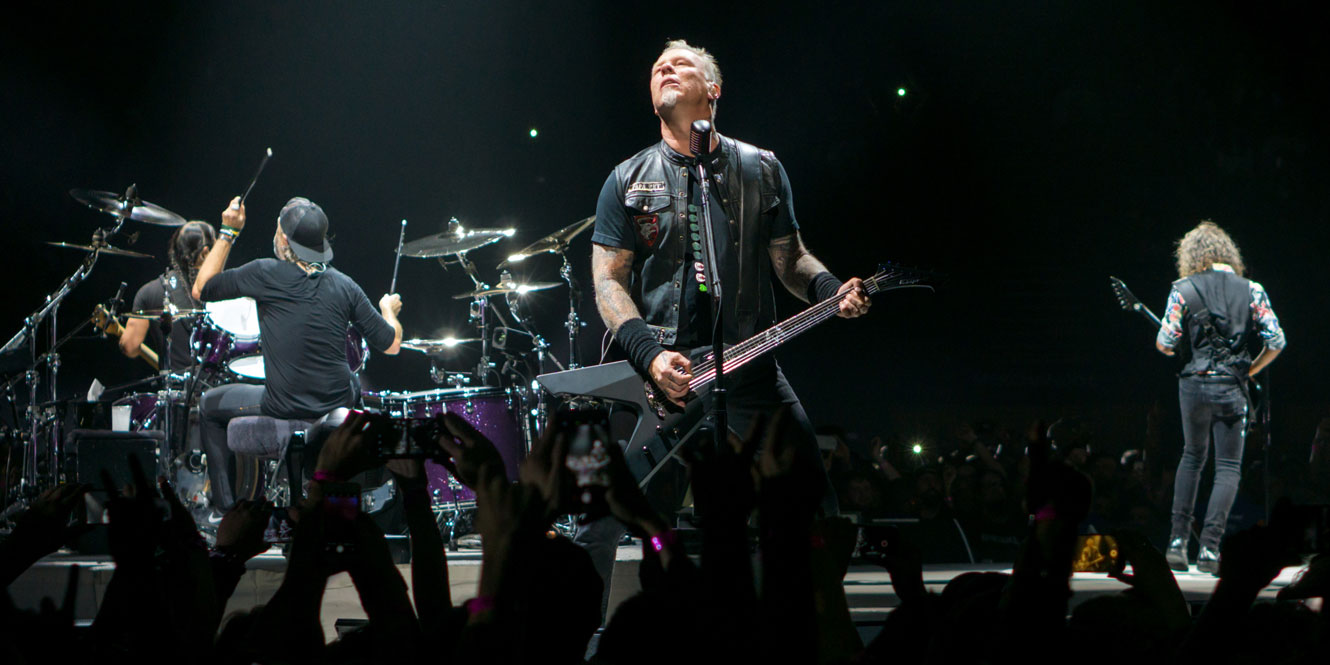
Creative Commons License by Raph_PH
Effects pedals
While Hetfield is renowned for his raw and powerful sound, he has also utilised effects pedals to enhance his tone throughout his career. Let’s explore some of the notable effects pedals that James Hetfield has incorporated into his setup:
ProCo Rat
Used since: 1983
The ProCo Rat is a classic distortion pedal known for its aggressive and gritty tone. Hetfield has been known to use this pedal to add a fuzzy, biting distortion to his guitar sound, particularly during Metallica’s earlier years.
Line 6 DM4 Distortion Modeler
Used since: 2002
The Line 6 DM4 is a versatile distortion pedal that emulates a range of classic distortion tones. Hetfield has utilised this pedal to experiment with different distortion flavours, from vintage-style to high-gain tones, expanding the sonic possibilities in his playing.
Line 6 DL4 Delay Modeler
Used since: 2002
The Line 6 DL4 is a versatile delay pedal that offers a wide range of delay effects, including vintage tape echo, digital delay, and modulation effects. Hetfield has incorporated this pedal to create ambient echoes and spacious textures in his playing.
Ibanez TS9 Tube Screamer
Used since: 1983
The Ibanez TS9 Tube Screamer is a legendary overdrive pedal that provides a warm and smooth tube-like tone. Hetfield has employed this pedal to add a touch of midrange boost and sustain, allowing his riffs to cut through the mix with clarity and presence.
Klon Centaur
Used since: 2012
The Klon Centaur is an infamous overdrive pedal known for its transparent and dynamic tone. While not extensively documented, Hetfield has reportedly used the Klon Centaur to add a touch of smooth overdrive and sustain to his sound.
MXR M107 Phase 100
Used since: Early-2010s
The MXR M107 Phase 100 is a phaser pedal that produces lush, swirling modulation effects. Hetfield has employed this pedal to add a psychedelic touch to his guitar sound, creating dynamic and sweeping phase effects in his playing.
Each of these effects pedals has contributed to Hetfield’s diverse sonic palette, allowing him to add unique textures to his already powerful sound. By combining these tools with his exceptional skill and creativity, Hetfield has been able to create a signature sound that is unmistakably his own.
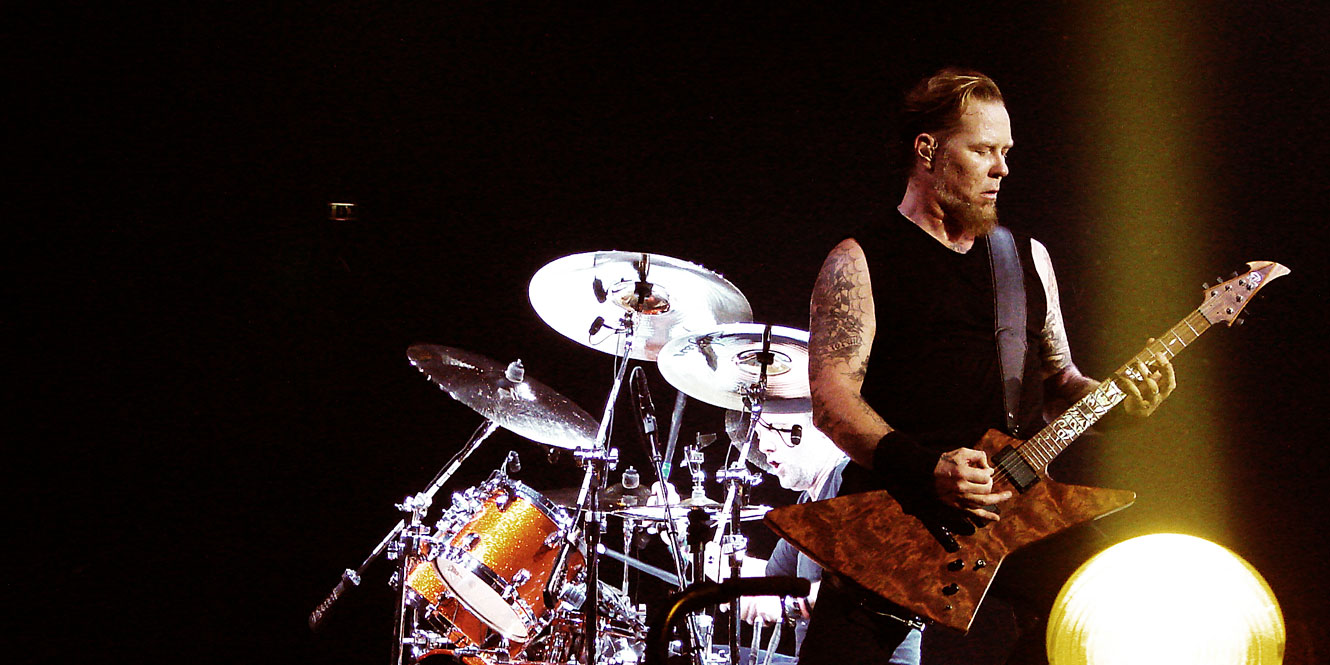
Creative Commons License by Mark Wainwright
Strings, picks, and accessories
Even the smallest details can have a significant impact on a guitarist’s sound. For Hetfield, his choice of strings, picks, and accessories is as essential to his sound as his choice of guitars, amplifiers, and effects.
From the Ernie Ball Power Slinky guitar strings (.11-.48) to the Dunlop Tortex.88mm these small but vital elements play a crucial role in Hetfield’s sound.
Guitar strings
The strings on a guitar are the heart of its sound, and Hetfield understands this better than anyone else. He uses Ernie Ball Power Slinkys, as well as his own custom gauge ‘Hardwired’ 11-50 set.
These strings provide the perfect balance of tone, sustain, and durability, making them the ideal choice for Hetfield’s aggressive playing style.
Guitar picks
Guitar picks may seem like a small detail, but for Hetfield, they’re an essential part of his gear. He uses Dunlop Tortex.88mm and James Hetfield Flow White Fang 1.0mm guitar picks, each offering a unique feel and attack.
These picks not only affect his playing technique but also contribute to the overall tone of his performances.
Hetfield’s picks are more than just tools for playing his guitar; they’re an extension of his musical identity. Whether he’s strumming powerful chords or delivering intricate solos, his choice of picks plays a crucial role in shaping his sound.
From their specific gauges to their unique materials, each pick is a testament to Hetfield’s commitment to quality and his relentless pursuit of the perfect tone.
FAQs
What kind of guitar does James Hetfield use?
James Hetfield has used Gibson and ESP guitars since he was a teenager. His main guitar is an Explorer-style made by Ken Lawrence, but he also owns a Gibson Flying V, as well as numerous ESP signature models.
What guitar is “Master of Puppets” played on?
The guitar used for “Master of Puppets” was James Hetfield’s Jackson King V Custom, nicknamed “Kill Bon Jovi”. The guitar features a white body finish, Tune-o-Matic bridge, Grover tuners and two Seymour Duncan Invader pickups.
What was James Hetfield’s first guitar?
James Hetfield’s first guitar was an Electra 2236 Flying V, a Gibson Flying V copy which featured on Metallica’s seminal Kill ‘Em All album.
Final thoughts
In the world of James Hetfield, every guitar, every amplifier, every string, and every pick plays a crucial role in crafting his iconic sound.
From his early days with the Electra 2236 Flying V and the Gibson Explorers to his custom creations with ESP and Ken Lawrence, Hetfield’s journey with guitars is a testament to his commitment to his craft.
His amplifiers and effects pedals, along with his choice of strings and picks, further enhance his sound, shaping the legendary tone we know and love.
Hetfield’s gear isn’t just a collection of instruments and equipment; it’s a sonic palette that he uses to paint his musical masterpieces.

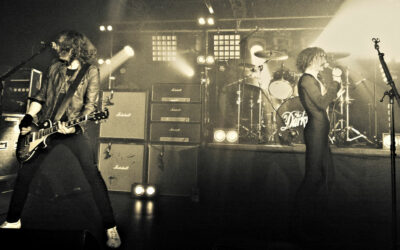
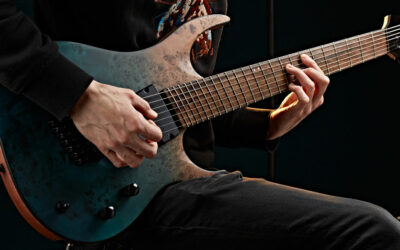
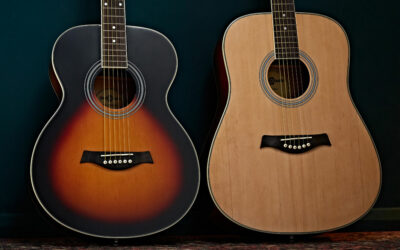

0 Comments